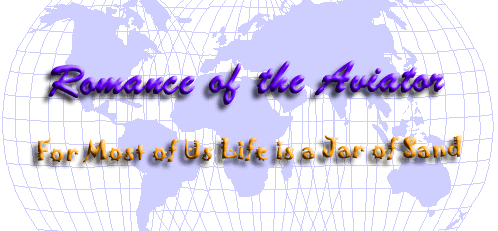![]()

![]()
Romance
and imagination and the human condition are all one and it is difficult to
separate one from the other. One is like an extension of the other, where
romance is an extension of imagination which is an extension of the human
condition. There are differing degrees and differing intensities, and for
certain human enterprises the degree of romance is stronger than in
others. Certainly, in the short and adventure filled history of the
aviator the romantic notion is at it's strongest. In order to understand
the romance of the aviator we have to understand the conditions of human
enterprise. Basically, we will have to understand why we view the aviator
as someone who accomplishes the impossible and what that means to earth
bound onlookers.
Completing any human enterprise is
like filling a glass jar laden with obstacles of rocks, or stones, or sand
or nothing, and how we complete it is our dilemma. The obstacles can be
the adversities of weather, or terrain, or natural disasters, or
constructs of the human condition in the form of tribes, and race
distinctions, and nations, and wars, and envy and hatred. The ability to
achieve our endeavor (and fill the jar) is determined by which obstacles
the jar is pre-filled with, and more importantly, by which material we
choose to complete the task.
| Each stone is the clear cutting of a virgin forest, and each grain of sand is the destruction of a species. |
Or we do like the Vikings and decide to sail to an unknown world; a world of myth and imagination. Then our glass jar is packed with the rock size obstacles of uncharted oceans, northern storms, freezing weather, hostile tribes, and the threat of starvation. It's a wonder why anyone would take on such an obviously formidable enterprise in the face of such adversity. How can we ever find the material to fill our vessel to completion when the obstacles are so many and the spaces so vast? Yet, the history of man is filled with such wonders of attempted human enterprise where successful or not the adventurers become the romantic icons of their age.
Most of the materials we use to fill these gaps and spaces are as rigid as the rocks they are meant to supersede. We use brute force, tooth and nail, speed, cunning, determination, cultivation, cooperation, socialization, and a combination of simple technologies to complete our endeavors. We use these materials no differently than do other living forms on earth, and consequently, because of their rigid structure, there remains numerous gaps and continuing spaces. You cannot fill a jar of rocks with stones, or a jar of stones with sand. Only by completely filling the remaining gaps and spaces does our enterprise become uniquely human in quality.
| Ants show strength, determination, cultivation, cooperation and socialization, but they don't build spiral towered castles in the sky. |
There is at least one special human material that allows us to fill our glass jars of enterprise much more efficiently than other living entities are capable of doing. This material needs to be as vast as the spaces we define and as fluid as the shapes of the remaining fractional spaces that the obstacles, by default, define. That material is imagination. Foxes will dig a hole in the ground in which to live. Man will build great castles and cathedrals defining, through their collective imaginations, a space so grandiose of ingenious design and sheer size that it will inspire fear and command respect, and thus further add to the safety of the owner over and above the physical presence of a shelter.
Thus we use imagination. Like a fluid it flows to fill every aspect and saturate every space of our existence. A step beyond cognitive ability or self awareness, and more so than logical thought, the material of imagination fills our human enterprises to overflowing. Despite the rocks and stones and sands of each attempt we make to better our condition, our imagination naturally flows like fluid around the obstacles to saturate and compete our reason for existence. As a furtherance, romance springs from the river of imagination.
| Romance is the product of fact and imagination, like wine is the product of grapes and sugar. |
Out of necessity man's imagination built great castles and massive stone walls using the crude materials of brute force and simple technology, but the obstacles of hurricanes, tropical storms, blizzards, and mountains, deserts, rain forests and vast oceans were just too difficult to breach on a continuing basis. The Phoenicians, the Vikings, the Polynesians and the Portuguese sailed their worlds proving that determination and manpower could overcome these obstacles, but not on any vast scale that proved timely or safe.
And then, through the force of sheer imagination, man invented the aircraft. Through trial and error man learned to fly. Man could now take a machine and pierce the hurricanes and the blizzards, and cross the deserts and the oceans and do what had always been thought impossible. The aviator was the actuary force of all our dreams. He was the force of our imagination and thus not real. He was an extension of reality. The aviator was romance incarnate.
The main method of solving any logistics problem is through brute force. Men can pull stumps and clear forests for crops. Flying, however, is not so easily grasped or readily tangible. When 5,000 out of the 11,000 pilots who died during WW1 died in training, the myth grew that only the select few could fly. It took a special intangible skill of a sportsman and gentleman to win over the demons of the air. Aviators were definitely a special breed.
| When a pilot appeared he appeared out of the sky. When a pilot disappeared, she disappeared forever. |
Progress, however, meant turning solo sojourns across the Atlantic into a viable business venture. If man was meant to fly, well then, the pilot was meant to be the prophet and the passengers his disciples. The early aviators would become the pioneers in running airlines, and were destined to start the world's rush into aviation enterprise.
For the early bush pilots and pioneers in aviation of the 1920's the technology was simply not there to provide a scheduled passenger service that ventured very far, let alone spanned the globe. If human enterprise is the equivalent of filling a glass jar, then most of us live our lives in a jar of sand. The difficulties are small but too numerous to overcome; miring us down before we can get too far. Occasionally, however, men find jars where the rocks are large and the space is plenty.
| If human enterprise is the equivalent of filling a glass jar, then most of us live our lives in a jar of sand. |
Progress does not work like that, however, and it took the imagination and determination of two men in particular to see the way around the "rocks" in their flight path. If brute force was not possible then there was only the fluid of imagination to fill the void. Only the force of imagination could brew the romantic notion that the incomparable freedom of flight more than makes up for the shackles of economic necessity.
 |
| If man could fly, well then, he could fly damn well anywhere. |
Essay by
John S Goulet
![]()
Note from the Editor. This
essay on romantic notion also applies to the beginnings of Canadian
Pacific Airways and Grant McConachie's' ambitious drive to connect Canada
with China and all the Pacific in-between by luxury airliner.
For that story see Bush
Pilot With A Briefcase.
 Top of this story.
Top of this story.
John S Goulet Editor
![]() Last modified on
January 06, 2015 .
Last modified on
January 06, 2015 .
© Virtual
Horizons, 1996.